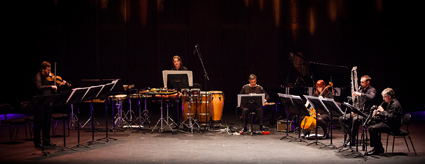the body in the instrument
greg hooper: elision, crossbows festival

ELISION, Crossbows
photo Sean Young
ELISION, Crossbows
IN THE CROSSBOW FESTIVAL FOR SMALL ENSEMBLES THE QUEENSLAND CONSERVATORIUM CONTINUES THEIR PRACTICE OF COMBINING NATIONAL, INTERNATIONAL AND STUDENT PERFORMERS IN CONCERTS OF CONTEMPORARY MUSIC.
Tonight it’s ELISION (plus four students) presenting six works, either Australian or world premieres, in the Conservatorium Theatre. It’s a traditional venue—stage up front, audience way down there. Great sound, but not as close to the performers as I’d like for what is a ‘small ensemble’ night.
The concert opens with Gyfu (gift) from Liza Lim. There are half a dozen music stands set up in a line to one side of the stage to give Peter Veale on oboe a clean look at the entire score—no turning pages. A good idea as the work is difficult, challenging, the sort of piece that gets played in competition. Veale gives his usual jaw dropping virtuosic display, technical brilliance completely subsumed to musicality. The upshot is a beautifully lyrical and sinuous performance with hints of Middle Eastern tonalities. Peter Neville’s accompanying percussion lilts, skips and dances, so that for a piece with such a modern language the effect is medieval and theatrical. Troubadours, duduks and multiphonics. Frame drums played with hairbrush and knucklebones.
Jump cut to the first Star Wars (the one that lauds people smugglers) and the introduction of the most annoying trope in sci-fi: the off-planet speakeasy with crazy plush puppets playing 30s future-retro space swing. Timothy McCormack’s One flat thing reproduced provides the rejoinder. The setup is a trio, Hot Club style. Neville sits cool and centre on drums, Veale hunches over with his oboe as though ready to pounce upon the score and Jennings stands to the side on violin. Fast and squeaky, chockablock with sex, humour, triumph and rejection, it’s the Kurt Weill bar for sleazy higher intelligences, unnatural alien superposition and quantum tunnelling between friends.
Benjamin Marks then follows solo on trombone, mute, and lots of singing into the mouthpiece for McCormack’s piece titled Here is a sequence of signs each having a sound and a meaning. The big brass can lend themselves to an element of silly, particularly when made to ‘talk,’ and Marks covers that for sure. But more than a bit of fun, or technical display, the piece develops into ranting hysterics, a frustrated diatribe against some diffuse, unknowable target. An incredible performance.
McCormack’s compositions then are full of character, yet this is in some ways surprising given the formal concerns expressed in his scores and interviews. We are used to the idea that the composer instructs the performer, via a score, to produce various pitches, notes and sounds for the listener. And traditionally the composer wants the listener to hear the sound, rather than hear the performer trying to make the sound. But McCormack has a different, maybe additional, aim—though one that reminds me of other ELISION composers such as Aaron Cassidy and Evan Johnson. McCormack deals with the physicality of production. He wants the audience to hear the underlying mechanisms, to hear the struggle between performer and instrument. His scores are filled with notations and equivocations that pull apart the different components of sound production into a number of autonomous strands of possible action. Performers are asked to make musical sense of the struggle to physically realise the conflicting and interlocking instructions in the score. The result is music that resonates with associations, a triumph of both the composer and the performers, and speaks to the deep connection this work has with the long history of music as an embodied communal experience, as a shared understanding of the effortful production of sound through the use of tools.
In yet another superb performance, Rebecca Saunders’ to and fro, for violin and oboe, gives violinist Graeme Jennings his time in the sun. Standing to the left of the stage, with Veale on oboe to the right, Jennings extracts a continual stream of flurrying harmonics that seem to exist within a thickness of sound. It is as though we can now hear the pitch of a note not as a frequency but as a domain of intricately related possibilities.
Finish the night with ELISION and student guests performing Richard Barrett’s wound i-v (strangely romantic with hints of the Scottish pastoral, rambling slide guitar like a half forgotten Pacific holiday) and codex one (the rush of swarming insects).
If anything, the now UK-based ELISION have grown since the last Queensland Labor government so stupidly cast them adrift. Virtuosic, technically and musically, individually and as an ensemble, we could once claim one of the world’s great contemporary music ensembles as our own. Now we can’t.
ELISION, oboe Peter Veale, horn Ysolt Clark, clarinets Richard Haynes, trombone Benjamin Marks, percussion Peter Neville, violin Graeme Jennings, cello Judith Hamann, electric guitar Daryl Buckley, with Queensland Conservatorium students; Crossbows: a festival for music for small ensembles; Conservatorium Theatre, Griffith University, Brisbane, May 11
RealTime issue #110 Aug-Sept 2012 pg. 50






